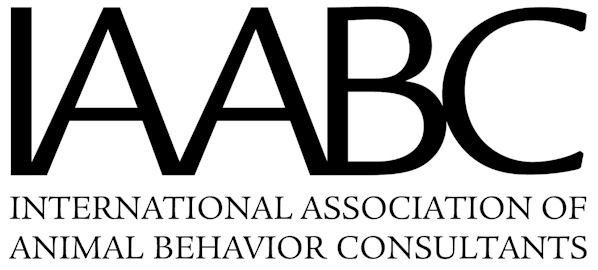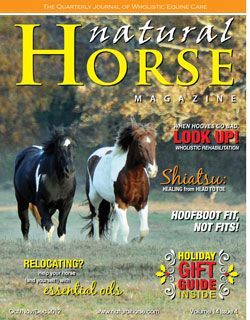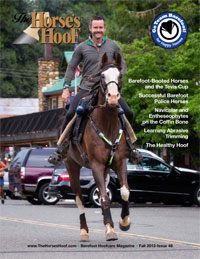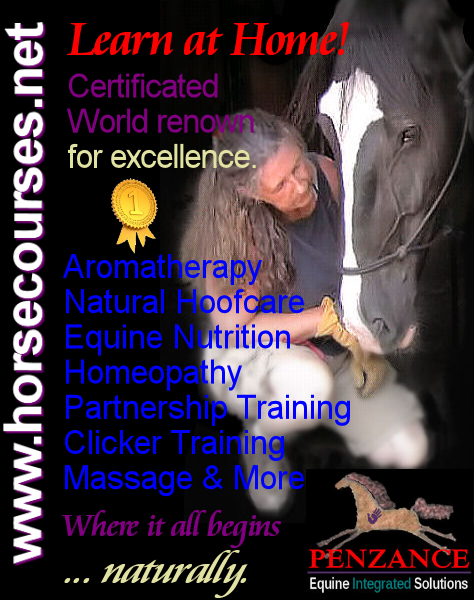I received a letter yesterday that was sharply revealing about the general lack of understanding about clicker training in the horse world. The letter, from an equestrian professional, stated that positive reinforcement and ‘natural horsemanship’ were two “competing” training methods and the topic is a very hot one today. While it may be true that the topic is popular the statement that the two are competing training methods is categorically wrong. Anyone who ‘trains’ horses uses at least one aspect of operant conditioning if not all aspects of it regardless of whether or not they think they are using ‘natural horsemanship’ or not. (What the heck IS “natural horsemanship” nowadays, anyway? The term has become so muddied over the last decade that its become much the same as ‘born again Christian’ … both terms leaving a strong feeling of either distaste or attraction … but both terms being unquestionably misunderstood.
My ‘mission’ in the horse world is to help horses by helping people understand how to work with them without punishment and undue force. Horses are extremely large animals that can do a major amount of damage in just the blink of an eye. They are also extraordinarily sensitive animals who can and do shut down, psychologically, in a moment’s notice. I work much of the time with those who have shut down due to stress, mishandling, trauma and abuse – phobic and traumatized 1200# animals whose first instinct is to run from threats, using hooves for protection. A large amount of time is also spent teaching these horses’ humans just what really is going on with their beloved horses and how to best help them in a restorative, gentle manner.
For this I use a mixture of positive reinforcement and negative reinforcement – both primary tools of clicker training. Both primary aspects of operant conditioning and both proven to be highly effective with PTSD and Phobias in animals as well as with humans.
Let’s define the words for easier reading and comprehension here.
OPERANT CONDITIONING: operant conditioning n.
POSITIVE REINFORCEMENT: positive reinforcement n.
A process of behavior modification in which a subject is encouraged to behave in a desired manner through positive or negative reinforcement, so that the subject comes to associate the pleasure or displeasure of the reinforcement with the behavior.
The American Heritage® Stedman’s Medical Dictionary 2002, 2001.
the offering of desirable effects or consequences for a behavior with the intention of increasing the chance of that behavior being repeated in the future. Dictionary.com’s 21st Century Lexicon 2003-2012. NEGATIVE REINFORCEMENT: negative reinforcement n.
the reinforcing of a response by giving an aversive stimulus when the response is not made and omitting the aversive stimulus when the response is made. Collins English Dictionary – Complete & Unabridged 10th Edition 2009
So, basically — OPERANT CONDITIONING is giving the animal a choice of response to a specific stimuli thus giving the animal the opportunity to control or operate his own environment. POSITIVE REINFORCEMENT [+R] is offering a reward for correct ‘answers’ with the intention of having the horse repeat the same response / behavior. NEGATIVE REINFORCEMENT [=R] is taking away an unpleasant stimulus when the ‘correct answer’ is given. (Think of removing leg pressure when the horse moves forward.)
Studies have shown that horses who are trained utilizing positive and negative reinforcement never forget their lessons and will remember years later even if said training methods had been suspended.
Nothing mystical, nothing extraordinary about all this as one can see that every good horseman will use one of these two conditioning tools at one time or another with his or her own horse. If we are teaching the horse to move forward from our leg pressure on his side and remove that pressure when he does, that’s -R. If we give him a “Good Boy!” and a piece of carrot for doing something we’ve asked, that’s +R.
Simple.
There are two other aspects of working with horses that are also part of operant conditioning but two aspects that I prefer NOT to use with horses.
POSITIVE PUNISHMENT and NEGATIVE PUNISHMENT.
I think, now, that the reader understands that “positive” means to “add something” to a teaching task and “negative” means to “take away” then one can deduce that Positive Punishment means to ADD and Negative Punishment means to TAKE AWAY. Both intending to reduce a particular behavior rather than to increase the chances of a specific behavior repetition.
Example: The horse is crowding into the handler so the handler jabs a crop into the shoulder of the horse to cause the horse to step away. The handler stops jabbing the horse when the horse steps away at an acceptable distance. This is POSITIVE PUNISHMENT.
If a horse crowds over the handler while the handler is putting a feed bucket in front of the horse then the food is taken away ‘for bad behavior’. This is NEGATIVE PUNISHMENT (something pleasant is removed as a result of undesirable behavior.)
Adding punishment to a horse’s environment causes extreme stress to the horse making it impossible for the horse to learn the lesson at hand (all he’s learning is that when he steps into the handler as detailed above he will get jabbed in the shoulder by an unpleasant or painful stimulus. (He’s singularly focused on the discomfort/pain of the jabs rather than the act of stepping back out of the handler’s space); taking away something pleasant for ‘bad behavior’ such as removing the food, simply causes the horse to focus on his primary need for food; he doesn’t learn the lesson at hand; it is impossible for him to do so. Studies have shown that in order for punishment to be effective in the manner of eliciting desireable behaviors, the punishment must be regularly applied to the particular situation/environment.
Remember, anything that causes the horse to go into flight mode means that his thinking is then currently on surviving – running away – as he is hardwired to do. Anything to add stress to that environment causes a deeper and stronger flight response. Because of this hardwiring, punishment makes it impossible for the horse to “learn a lesson” other than how to avoid receiving the stressful, painful punishment.
On the other hand, when a PLEASANT stimulus is given to the horse for a particular behavior the horse will strive to repeat that particular behavior over and over again. He is not worried about surviving; his focus is on how to ‘feel good’ again. Thus a repeat of the behavior that brought the ‘reward’. This, too, is a physiological response as much as the response to punishment is. When a horse ANTICIPATES a ‘feel good’ situation then the DOPAMINE ¹ levels in his brain spike. Dopamine is the chemical in the brain that causes the feeling of pleasure.
- The pleasurable feeling that comes with the successes is brought aboutby a surge in the neurotransmitter dopamine.
- Receptors located in the brain’s dopamine reward system reinforce the good feelings that these activities bring.
So, to summarize briefly:
Positive and Negative Reinforcement causes the horse to FEEL GOOD and because of that the horse will focus on what makes him feel good and will try to repeat the behaviors that bring him pleasure.
Positive and Negative Punishment causes the horse to FEEL THREATENED and because of that the horse will focus, as hardwired to do, on flight/running a way to avoid the punishment and thus be unable to learn the task at hand permanently.
“Natural Horsemanship”, by definition, uses methods of teaching and training horses that keep the horse’s NATURAL dispositions in primary focus. Using the horse’s natural socio-behavioral tendencies as guidelines to the training methods employed. Unfortunately, the term, as stated, has become a tenet for many different viewpoints of ‘training’ the horse i.e. kicking the horse in the gut as a ‘mare disciplines an offending herd member’. Or, ‘biting’ the horse with a sharp yank on the rope halter which causes pain to the face of the horse or being the “alpha mare” which deems one must ‘dominate’ the horse with intimidation and force. These examples fall far from what is considered ‘gentle’ horse training methods as ‘natural horsemanship’ is generally, and originally, defined to be. To add to this, none of the examples are correct except in extreme cases when the ‘offending horse’ refuses to listen to what the other horse is “saying”. There are many behaviors and communications that occur before aggressive biting and kicking takes place. One who professes to use ‘natural horsemanship’ needs to learn equine communication and behaviors before resorting to intimidation and bullying tactics in his or her training. Otherwise, it is my opinion, that the ‘trainer’ is exhibiting nothing more than force, intimidation and restraint or … positive punishment training.
This may well offend many trainers and if so, to them I say, instead of wasting your energies on feeling offended and defensive and figuring ways to disprove positive reinforcement training, educate yourselves on Equine Behavior and Equine Sociopsychology. We humans live in a world where we grovel to our egos unless, by choice and thought, we choose to do otherwise. Horses live in a world that is polar opposite from that and focuses, instead, on simply – surviving, procreating and existing peacefully within a family group that is part of a large social herd.
References –
1. Dopamine – and its derivative, norepinephrine – are considered a single chemical. This is the energizing, “gas petal” chemical that promotes increased feelings of alertness, wakefulness, assertiveness and aggressiveness. This chemical heightens energy, speeds up thoughts and improves muscle coordination. Too much norepinephrine causes anxiety and aggression, stimulates violent behaviors, and causes schizophrenia, paranoia and psychosis.
Neurotransmitters – are hormone-like chemicals that work on the central nervous system and affect not only the brain, but the entire body. Neurotransmitters are messenger chemicals that create feelings, stimulate thoughts and trigger memories. There are three important neurotransmitters to know about. Serotonin – norepinephrine – dopamine
Serotonin – Key words are well being and peacefulness. Serotonin boosts feelings of optimism, self esteem, relaxation, and security. Adequate levels ensure good concentration and deep sleep. The more serotonin you have, the less pain.











Regarding your examples of positive punishment and negative punishment, I can’t think of anyone who doesn’t use some variant of them in these types of instances. These behaviors (crowding the handler, rudely grabbing for the food bucket), are just plain dangerous, even if it’s a mini (ask me how I know). On the other hand, examples of inappropriate punishment would indeed include rough chain shanking or whipping for, say, not standing square, or for inquisitive behaviors that may “get in the person’s way” or otherwise non-dangerous behaviors, I agree punishment is inappropriate in these cases, and those harsh punishments are never appropriate. I will most often use the sharply spoken “uh-uh” for the “wrong” answer; I also won’t give the food bucket as a reward for crowding, but will instantly give it the second the horse stops. THEN, we can work on being polite and patient, and put the wait on cue, even build in some duration. I think once the initial bad behavior is stopped by some form of “punishment” (balanced in degree to the degree of badness; not excessive nor prolonged), then positive reinforcement can better be used to build good behavior in its place. it can be a long time before a habitual crowder accidentally steps back so you can reward him; and whoever heard of a horse voluntarily waiting for his food bucket? 😉